 25.05.2025
25.05.2025
 25.05.2025
25.05.2025
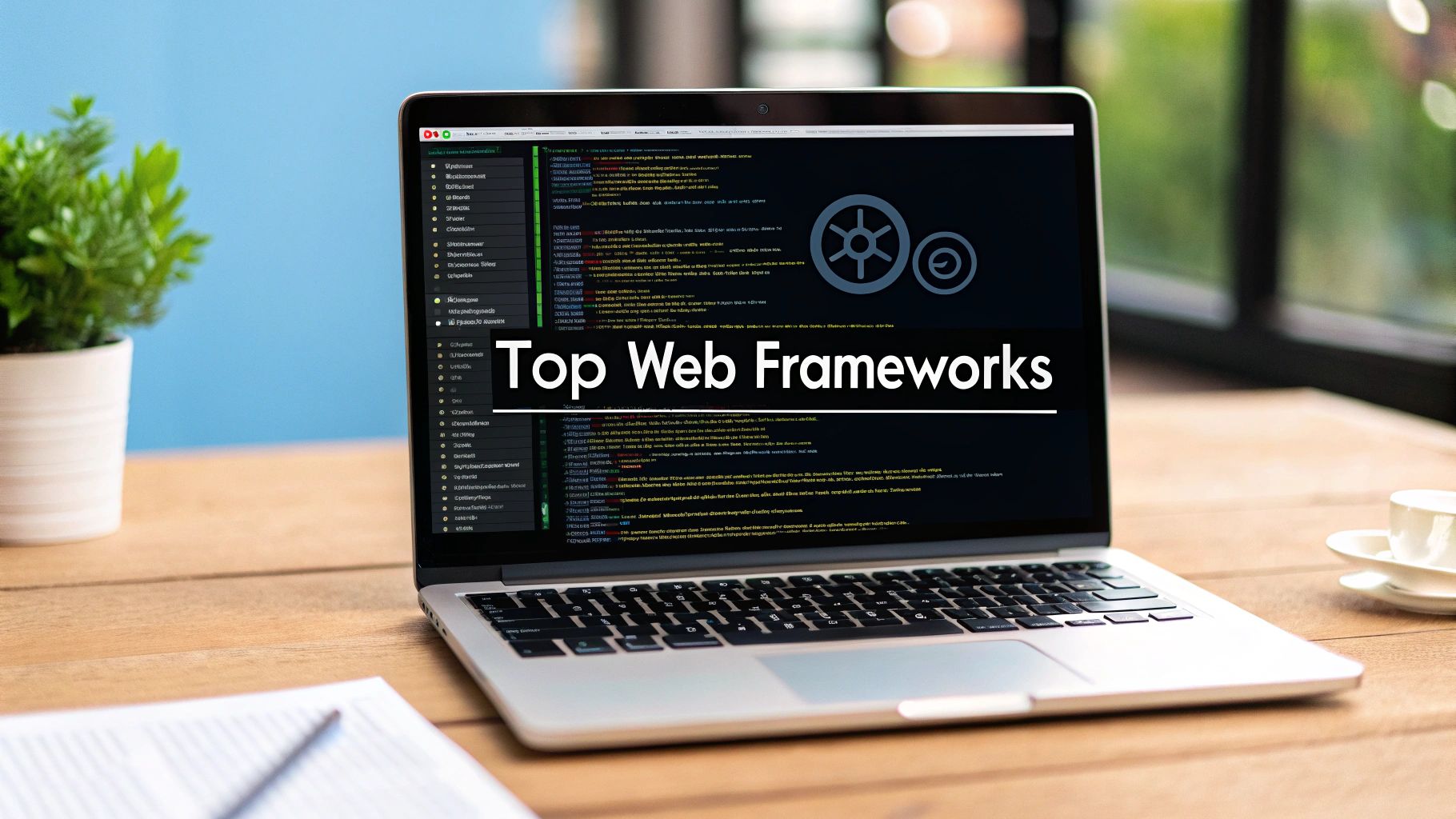
Building a successful web application requires the right tools. This list of 10 popular web frameworks will help UK business owners like you choose the best foundation for your project. Web frameworks streamline development, saving time and resources by providing pre-built components and structure. Learn about the strengths of React, Angular, Vue.js, Express.js, Django, Ruby on Rails, Next.js, Laravel, Spring Boot, and Flask to make an informed decision for your next web development venture. Choosing wisely among these popular web frameworks is crucial for a successful project.
React is a leading JavaScript library, developed and maintained by Facebook (now Meta), widely adopted for building dynamic and interactive user interfaces, particularly single-page applications. While not a full-fledged framework in the traditional sense, its extensive ecosystem and widespread use make it a cornerstone of modern web development and a strong contender among popular web frameworks. React's component-based architecture, coupled with its efficient virtual DOM, allows developers to create complex UIs with improved performance and maintainability. This makes it a powerful choice for businesses in the UK looking to develop sophisticated web applications.
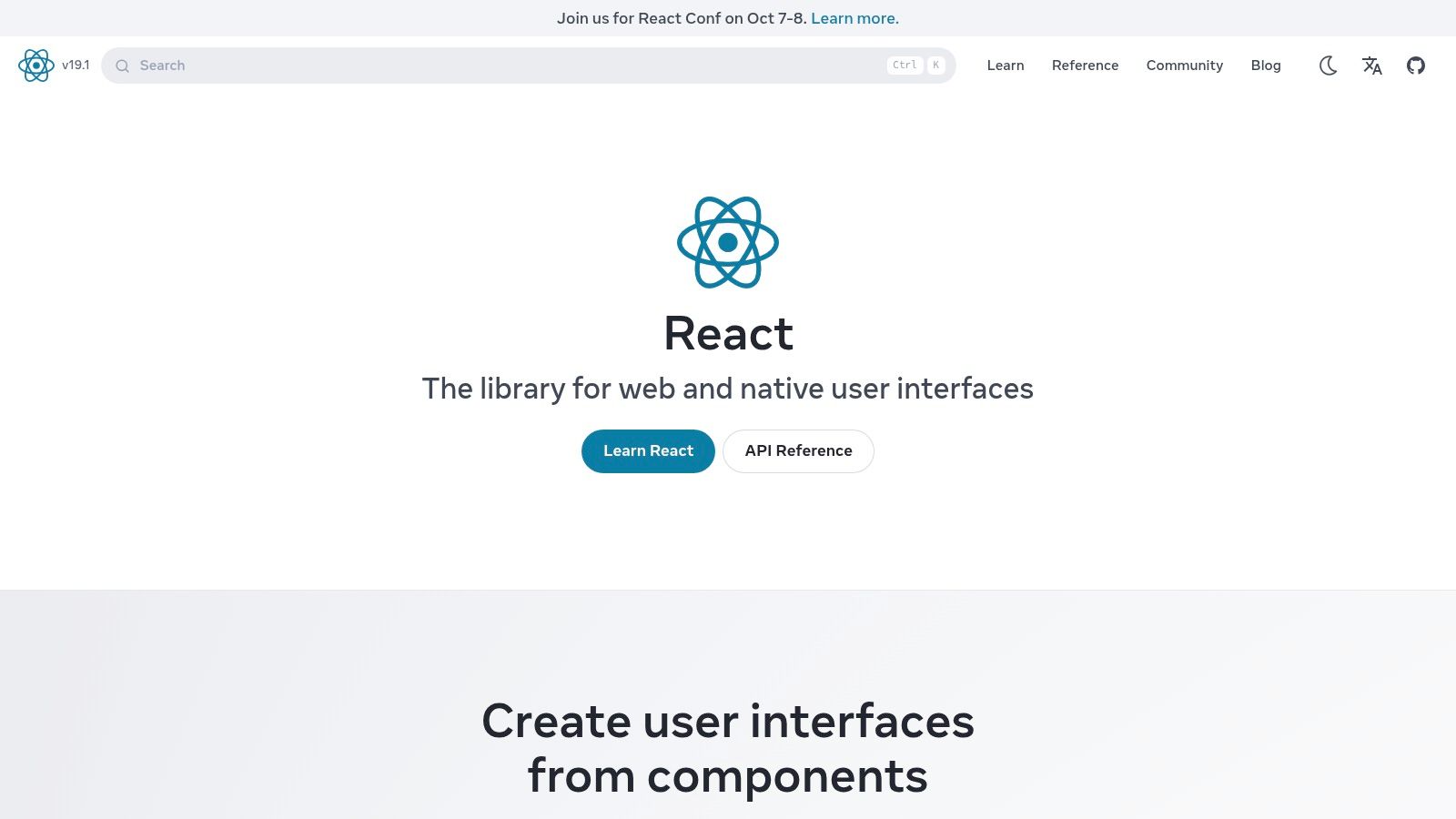
React's popularity stems from its focus on building reusable UI components. Imagine building with Lego bricks – each component represents a self-contained piece of the UI (like a button, a form, or a product card), which can be combined and reused to create complex layouts. This modularity significantly speeds up development, reduces code duplication, and makes maintenance much easier. The virtual DOM further enhances performance by minimizing direct manipulations to the actual DOM, leading to a smoother user experience.
Features & Benefits:
Component-Based Architecture: Develop reusable UI elements, promoting code maintainability and reducing development time. This is particularly beneficial for large projects and growing businesses.
Virtual DOM: React's virtual DOM efficiently updates only the necessary parts of the actual DOM, resulting in faster rendering and improved performance, crucial for a positive user experience.
JSX: This syntax extension allows developers to write HTML-like code within JavaScript, simplifying the creation of UI elements and making the code more readable.
One-way Data Binding: Ensures predictable data flow, making debugging easier and reducing the risk of unexpected behavior.
Extensive Ecosystem: Benefit from a rich selection of community-built tools and libraries like Redux (for state management), React Router (for navigation), and Next.js (for server-side rendering), allowing you to tailor your development environment to your specific needs. This vast ecosystem offers solutions for virtually any web development challenge.
Pros:
Excellent Performance: The virtual DOM implementation makes React applications highly performant.
Strong Community Support: A large and active community provides ample resources, tutorials, and support for developers.
Backed by Meta: Continued development and support from Meta ensure the long-term viability of the library.
Flexible Integration: React seamlessly integrates with other libraries and frameworks, giving developers the freedom to choose the best tools for the job.
Cons:
Learning Curve: React can be challenging for beginners due to concepts like JSX and component lifecycle.
Not a Complete Framework: Requires additional libraries for routing and state management, adding complexity to project setup.
Frequent Updates: Staying up-to-date with the latest best practices and patterns can require ongoing learning and adaptation.
Implementation & Setup:
Setting up a React project is relatively straightforward thanks to tools like Create React App. This tool simplifies the initial project setup and configuration, allowing you to focus on building your application.
Pricing:
React is open-source and free to use.
Website: https://reactjs.org/
React's component-based architecture, performance benefits, and extensive ecosystem make it a powerful choice for UK businesses seeking to build modern, scalable, and high-performing web applications. While it does have a learning curve, the long-term benefits in terms of maintainability, performance, and developer productivity make it a worthwhile investment. Its flexibility allows it to adapt to the evolving needs of businesses, making it a future-proof choice for web development.
Angular, developed and maintained by Google, secures its spot as one of the most popular web frameworks due to its comprehensive and robust nature. It's a complete, TypeScript-based solution for building complex, enterprise-scale web applications. Unlike some lighter-weight frameworks that focus solely on the view layer, Angular provides built-in features covering routing, form validation, HTTP communication, and state management, offering everything you need in one tightly integrated package. This makes it a particularly strong contender for large projects where maintainability and scalability are paramount.
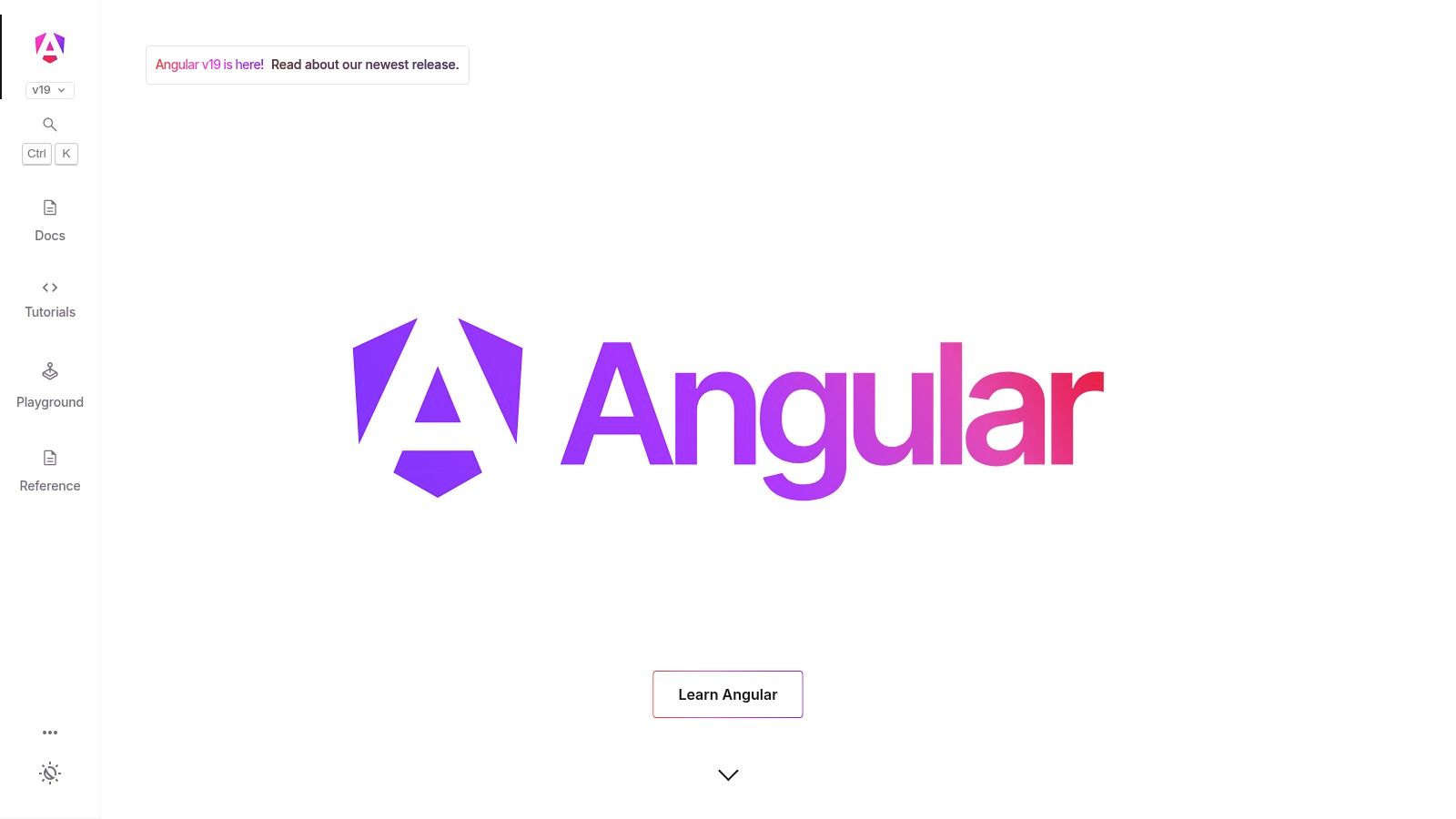
Angular follows the Model-View-Controller (MVC) architectural pattern, promoting a clear separation of concerns and making your codebase more organised and manageable. This framework is especially well-suited for UK businesses developing sophisticated applications, such as large-scale e-commerce platforms, internal management systems, or data-intensive dashboards, where structure and testability are crucial.
Key features that make Angular stand out include its powerful two-way data binding, which keeps your model and view synchronized in real-time, reducing development time and complexity. Its dependency injection system enhances testability and maintainability by making it easier to manage dependencies and swap out components for testing purposes. Furthermore, the comprehensive CLI (Command Line Interface) streamlines project scaffolding, building, testing, and deployment, boosting developer productivity. Angular's built-in TypeScript support brings the benefits of strong typing to your project, catching errors during development rather than at runtime, leading to fewer bugs and a more robust application. Finally, integration with RxJS facilitates reactive programming patterns, enabling you to handle asynchronous operations and complex data streams efficiently.
Pros:
Complete Solution: Provides all the necessary tools and features out-of-the-box.
Strong Typing: TypeScript reduces runtime errors and improves code maintainability.
Ideal for Enterprise Applications: Excellent for large, complex projects where scalability and maintainability are key.
Detailed Documentation and Style Guides: Provides comprehensive resources for developers.
Cons:
Steeper Learning Curve: Requires more time and effort to master compared to simpler frameworks.
Verbosity: Can be more verbose and complex than lighter alternatives.
Overkill for Smaller Projects: Might be too heavy and complex for small, simple applications.
Heavier Initial Bundle Size: Can impact initial load times, especially for less optimized applications.
Technical Requirements: Node.js and npm (Node Package Manager) are required to develop and run Angular applications.
Pricing: Angular is open-source and free to use.
Comparison: While React and Vue.js are also popular choices and might be quicker to learn, Angular provides a more complete and structured solution ideal for larger projects. React, for example, often requires additional libraries for features like routing and state management, whereas these are built into Angular.
Implementation Tip: Use the Angular CLI to scaffold your project, generate components, services, and modules, and manage your build process. This drastically speeds up development and enforces best practices.
Website: https://angular.io/
Angular's comprehensive features, strong focus on testability, and maintainability make it a top choice for businesses in the UK looking to build robust and scalable web applications. While the learning curve is steeper than some alternatives, the long-term benefits of using a structured and well-supported framework like Angular often outweigh the initial investment in training and development time.
Vue.js is a progressive JavaScript framework that's making waves amongst popular web frameworks, particularly for building dynamic and interactive user interfaces. Created by Evan You, its design philosophy centres around incremental adoptability, meaning you can integrate Vue.js into existing projects piece by piece, rather than needing a complete overhaul. This flexibility makes it a compelling choice for businesses in the UK looking to enhance their web presence without starting from scratch. Vue.js cleverly combines desirable aspects of Angular and React, prioritising simplicity and a gentler learning curve. This translates to quicker development times and potentially lower development costs, a significant advantage for businesses. It employs a reactive data-binding system and a component-based architecture much like React, but presents these concepts in a more approachable way.

Vue.js truly shines in its practical applications. Its flexible nature allows it to power anything from single-page applications (SPAs) providing rich, interactive experiences, to individual components within existing websites, boosting interactivity and user engagement. Imagine enhancing your product pages with dynamic filtering and sorting options, or creating an engaging interactive map powered by real-time data – Vue.js can handle these tasks with ease. For UK businesses looking to create engaging customer dashboards or intuitive internal tools, Vue.js offers a robust yet manageable solution. Learn more about Vue.js for deeper insights into its versatility.
Key features that make Vue.js stand out amongst popular web frameworks include its reactive and composable view components, which ensure efficient updates and a modular development approach. Its simple and flexible templating syntax makes development faster and more maintainable. Furthermore, Vue.js comes with built-in transitions and animation systems, enabling you to create visually appealing interfaces that enhance user experience. The Vue CLI (Command Line Interface) streamlines project scaffolding and management, while Vuex provides robust state management capabilities for complex applications. For handling navigation within your application, Vue Router offers a comprehensive routing solution.
Pros:
Gentle learning curve: Excellent documentation and a straightforward syntax make Vue.js relatively easy to learn, even for developers new to JavaScript frameworks. This reduces training time and accelerates project development.
Flexible integration: Vue.js can be integrated into existing projects gradually, making it suitable for both small enhancements and large-scale application development.
Small size and high performance: The core library is remarkably small (10-20KB), contributing to faster loading times and improved website performance, a crucial factor for user experience and SEO.
Growing ecosystem and community support: While smaller than React or Angular, the Vue.js community is active and supportive, providing ample resources and assistance.
Cons:
Smaller ecosystem: Compared to React or Angular, Vue.js has a smaller ecosystem of third-party libraries and tools, although it is rapidly growing.
Fewer large corporate backers: While this doesn't directly impact functionality, it can sometimes mean fewer readily available resources compared to frameworks backed by tech giants.
Flexibility can lead to inconsistencies: The flexibility of Vue.js can, without careful planning and established guidelines, sometimes result in varying implementation patterns across a project.
Vue.js is open-source and free to use. Its official website, https://vuejs.org/, provides comprehensive documentation, tutorials, and community resources. For UK businesses looking for a performant, flexible, and relatively easy-to-learn framework for their next web project, Vue.js is definitely worth considering among the popular web frameworks available today.
Express.js is a minimalist and flexible Node.js web application framework that provides a robust set of features for web and mobile applications. It's become the de facto standard server framework for Node.js and is a key component of popular technology stacks like MEAN (MongoDB, Express.js, AngularJS, Node.js) and MERN (MongoDB, Express.js, React, Node.js). Express.js provides a thin layer of fundamental web application features without obscuring Node.js features, making it ideal for building APIs and web applications, particularly those requiring high performance and scalability. For UK business owners looking for efficient and scalable solutions, Express.js offers a powerful backend framework to support your online presence.
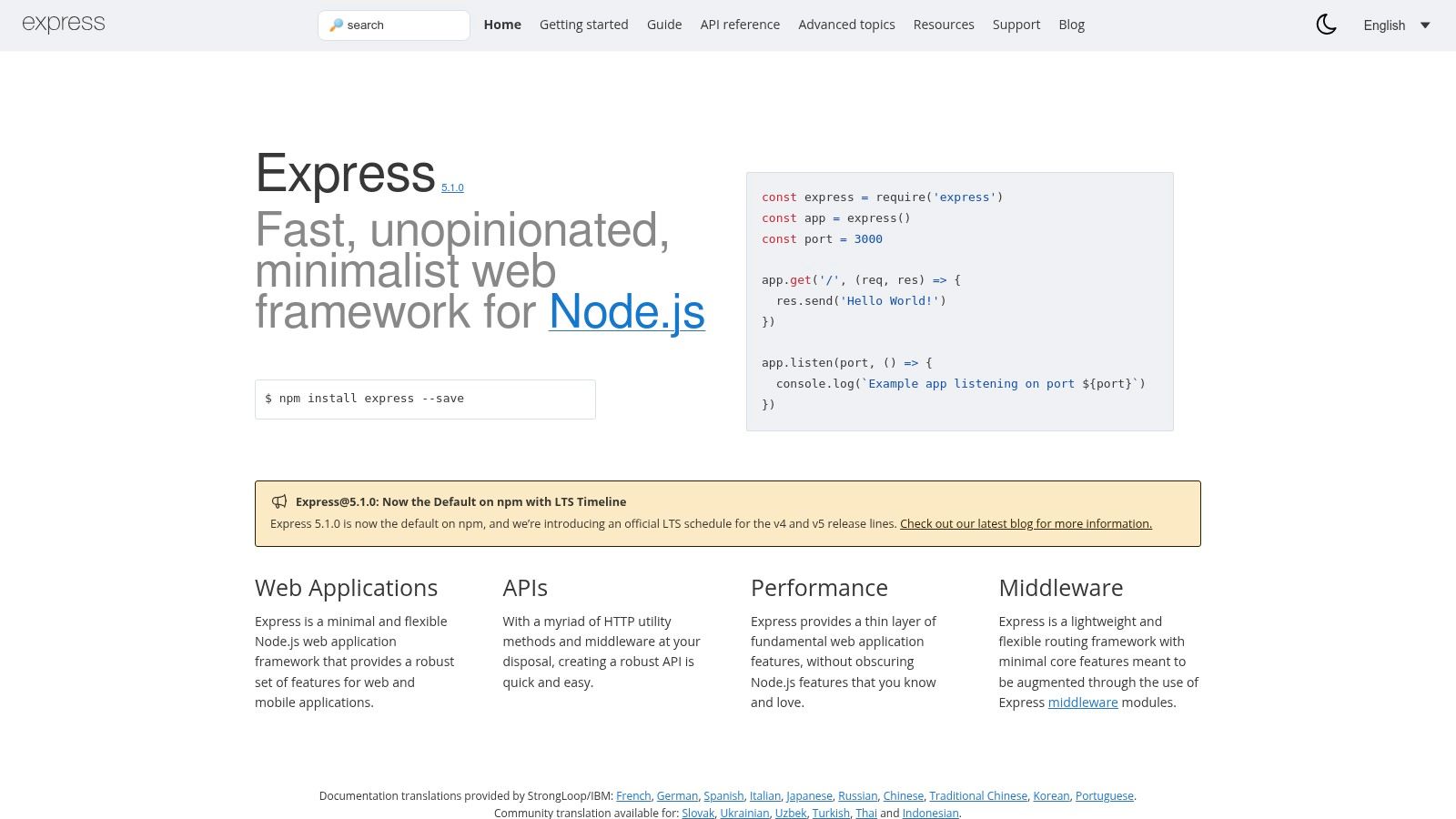
Express.js's middleware architecture is central to its functionality. Middleware functions handle requests and responses, allowing developers to perform tasks like logging, authentication, and data validation before passing control to the next middleware. Its robust routing system simplifies handling various HTTP requests, making it straightforward to define endpoints and manage different API versions. Template engine integration facilitates server-side rendering, enabling dynamic content generation. Furthermore, built-in error handling mechanisms help manage exceptions gracefully, and the framework provides easy serving of static files like images and CSS.
For business owners, this translates to faster development cycles and more responsive web applications. Express.js excels in building RESTful APIs, which are crucial for connecting different parts of your online business, including web applications, mobile apps, and third-party services. Its minimalist and unopinionated nature gives developers flexibility, allowing them to choose the tools and libraries that best suit their specific needs. This translates to cost-effectiveness, as developers can leverage existing resources and expertise.
The extensive ecosystem of middleware and plugins readily available for Express.js further simplifies development. Need authentication? There's a middleware for that. Need to connect to a specific database? There's a package for that. This extensive library of ready-made solutions dramatically speeds up development, reducing time-to-market for your web applications.
However, Express.js's minimalist approach also means that developers have to make more decisions about project structure and choose the right tools for various tasks. There's no pre-defined structure for larger applications, potentially requiring more upfront planning. Learn more about Express.js for deeper insights. Additionally, while Express.js itself is free to use (being open-source), building and maintaining a complex application requires investment in developer time and potentially paid third-party services. Its callback-based architecture, while efficient, can lead to the infamous "callback hell" if not managed carefully with techniques like promises and async/await.
Compared to more opinionated frameworks like Ruby on Rails or Django, Express.js provides more freedom but also necessitates greater developer experience and more careful planning. However, for projects requiring high performance, scalability, and flexibility, especially in building APIs, Express.js is a powerful choice that deserves its place among popular web frameworks. It empowers UK businesses to build robust and efficient web applications tailored to their exact needs, enabling growth and innovation in today's competitive digital landscape.
Django is a high-level Python web framework that's a popular choice for building robust and scalable web applications. It's known for its "batteries-included" philosophy, providing a comprehensive set of tools and features that streamline the development process, allowing developers to focus on building their application logic rather than reinventing the wheel. This makes Django a strong contender among popular web frameworks, particularly for businesses seeking rapid development and robust solutions.
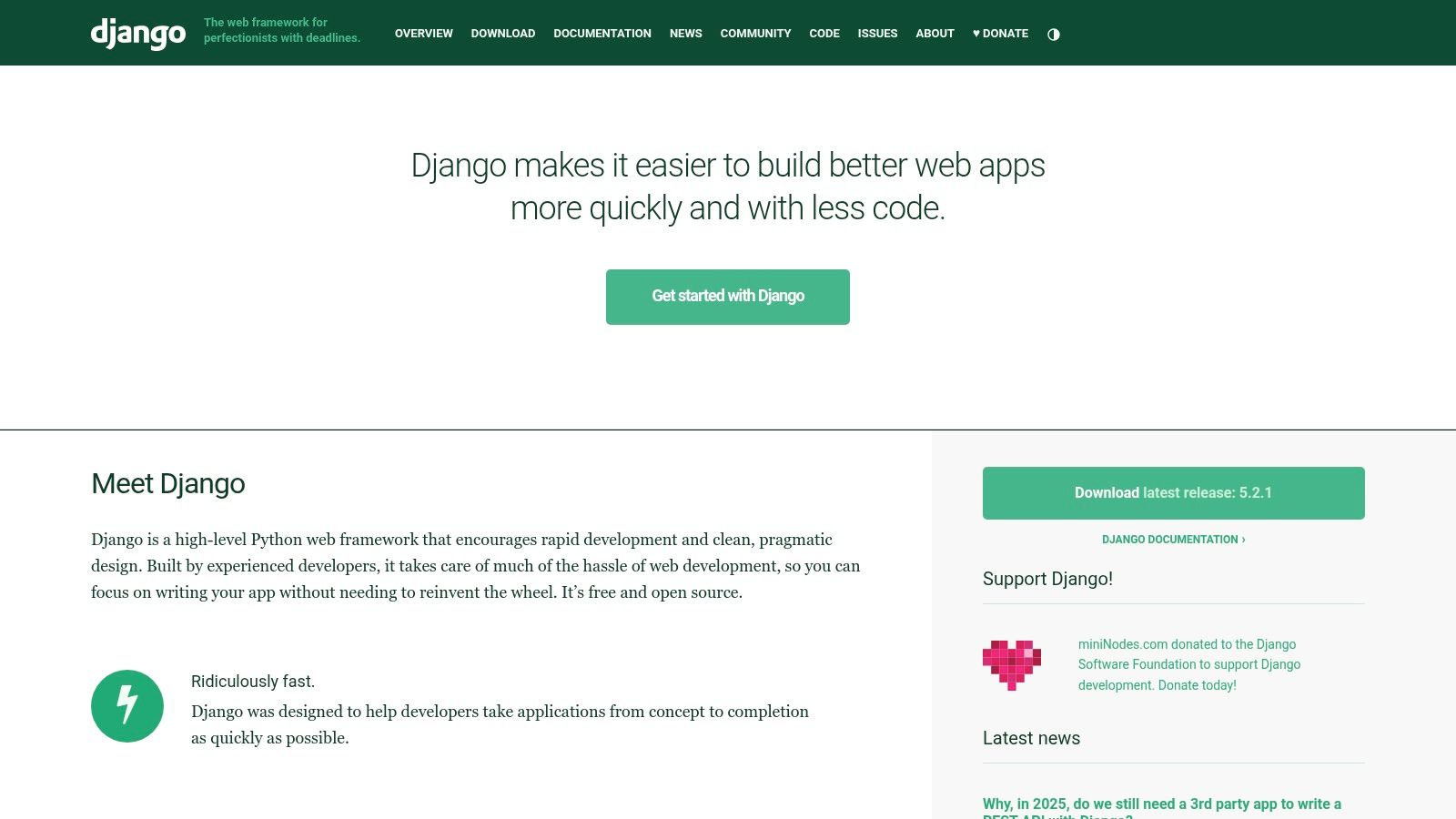
Django's Object-Relational Mapper (ORM) simplifies database interactions, allowing developers to work with databases using Python code rather than writing raw SQL queries. Its built-in admin interface provides a user-friendly way to manage website content, which is a huge time-saver for businesses. Security is a key strength, with Django offering built-in protection against common web vulnerabilities like cross-site scripting (XSS) and cross-site request forgery (CSRF). Its URL routing system and templating engine further contribute to a clean and organized development experience.
Key Features and Benefits for UK Businesses:
Rapid Development: Django's "batteries-included" approach significantly speeds up development, allowing UK businesses to get their products or services to market faster.
Enhanced Security: Built-in security features protect against common web vulnerabilities, crucial for businesses handling sensitive customer data.
Scalability: Django's architecture is designed to handle both small and large projects, offering scalability as your UK business grows.
Cost-Effective: As an open-source framework, Django is free to use, reducing development costs for businesses.
Strong Community & Documentation: Excellent documentation and a large, active community provide ample support for UK developers working with Django.
Pros:
Comprehensive feature set out of the box.
Strong emphasis on security with protection against common vulnerabilities.
Excellent documentation and large community support.
Scalable architecture suitable for both small and large projects.
Cons:
Can be overkill for very simple applications or microservices.
Monolithic approach might not be ideal for all modern architectures.
Steeper learning curve for beginners compared to some simpler frameworks.
Comparison with similar tools: Compared to frameworks like Flask (another Python framework), Django provides more structure and built-in features, making it suitable for complex applications. Flask, on the other hand, offers more flexibility and is often preferred for smaller projects or microservices. If you are building a complex web application in Python and need a robust, secure, and scalable solution, Django is a strong choice. If you need more flexibility and a minimalist approach, Flask might be a better fit.
Implementation/Setup Tips:
Use a virtual environment to manage project dependencies.
Follow Django's official documentation for installation and project setup.
Leverage Django's built-in admin interface for content management.
Technical Requirements:
Python (version 3.8 or higher recommended)
A database server (PostgreSQL, MySQL, SQLite, Oracle)
A web server (e.g., Apache, Nginx)
Pricing: Django is open-source and free to use.
Website: https://www.djangoproject.com/
Django's comprehensive features, security focus, and scalability make it a compelling choice for UK businesses looking to develop powerful and secure web applications. While it may not be the best fit for every project, its strengths make it a deservedly popular web framework.
Ruby on Rails, often simply called Rails, earns its spot among popular web frameworks due to its focus on developer productivity and elegant code. It's a server-side web application framework written in Ruby, utilizing the Model-View-Controller (MVC) architectural pattern. This provides a robust structure for databases, web services, and web pages, facilitating a streamlined development process. Rails adheres to software engineering best practices like Convention over Configuration (CoC), Don't Repeat Yourself (DRY), and the Active Record pattern, promoting maintainable and efficient code. This makes it particularly attractive for startups and businesses looking to rapidly prototype and deploy web applications.

For UK business owners, Rails offers several advantages. The "convention over configuration" philosophy drastically reduces decision fatigue for developers, allowing them to focus on building features rather than configuring intricate settings. This translates to faster development cycles and reduced time to market, crucial for businesses in a competitive landscape. The Active Record ORM simplifies database interactions, making data management more efficient. Built-in testing frameworks and fixtures contribute to higher quality code and fewer bugs, saving on long-term maintenance costs. Rails' asset pipeline streamlines the management of JavaScript and CSS assets, while Action Mailer simplifies handling emails, crucial for any online business. Furthermore, the extensive ecosystem of gems (plugins) provides readily available solutions for various functionalities, further accelerating development.
While Rails excels in rapid development, it's important to consider its potential drawbacks. Performance can sometimes be a concern, particularly compared to frameworks like Node.js or Go, especially for applications requiring high concurrency. The learning curve associated with the Ruby language and Rails conventions might require initial investment in training or experienced developers. Rails applications can also be resource-intensive, potentially demanding more server resources compared to leaner frameworks. Finally, the opinionated nature of Rails, while beneficial for many projects, can sometimes feel restrictive for applications with highly unconventional requirements.
Features:
Convention over configuration
Active Record ORM
Built-in testing frameworks
Asset pipeline
Action Mailer for email handling
Pros:
Rapid development speed and high developer productivity
Maintainable code due to strong conventions
Rich ecosystem of gems (plugins)
Built-in security features and regular updates
Cons:
Potential performance bottlenecks compared to some frameworks
Learning curve for Ruby and Rails
Can be resource-intensive
Opinionated nature might be limiting in some cases
Technical Requirements: A server environment capable of running Ruby (Linux servers are common choices). Database software (PostgreSQL, MySQL, SQLite are commonly used).
Pricing: Ruby on Rails itself is open-source and free to use. However, costs will be associated with server infrastructure, database hosting, and potentially developer salaries.
Comparison: Compared to frameworks like Django (Python) or Laravel (PHP), Rails often prioritizes developer experience and rapid prototyping. While Django and Laravel offer similar MVC structures, Rails' community and gem ecosystem are often considered strengths.
Implementation Tip: Start with a simple tutorial or a well-structured online course to grasp the fundamentals of Ruby and Rails conventions. Leverage the vast community and available documentation for troubleshooting and guidance. Consider using a cloud-based platform like Heroku or AWS for simplified deployment.
Website: https://rubyonrails.org/
Next.js is a powerful React framework that's gaining significant traction among developers, especially for building complex and performant web applications. It empowers developers to create robust, SEO-friendly websites and web apps by leveraging server-side rendering (SSR) and static site generation (SSG). Developed by Vercel, Next.js is designed to streamline the development process and enhance the user experience. This framework excels in scenarios requiring fast loading times, strong SEO performance, and dynamic functionality, making it a popular choice for businesses seeking a cutting-edge web presence.
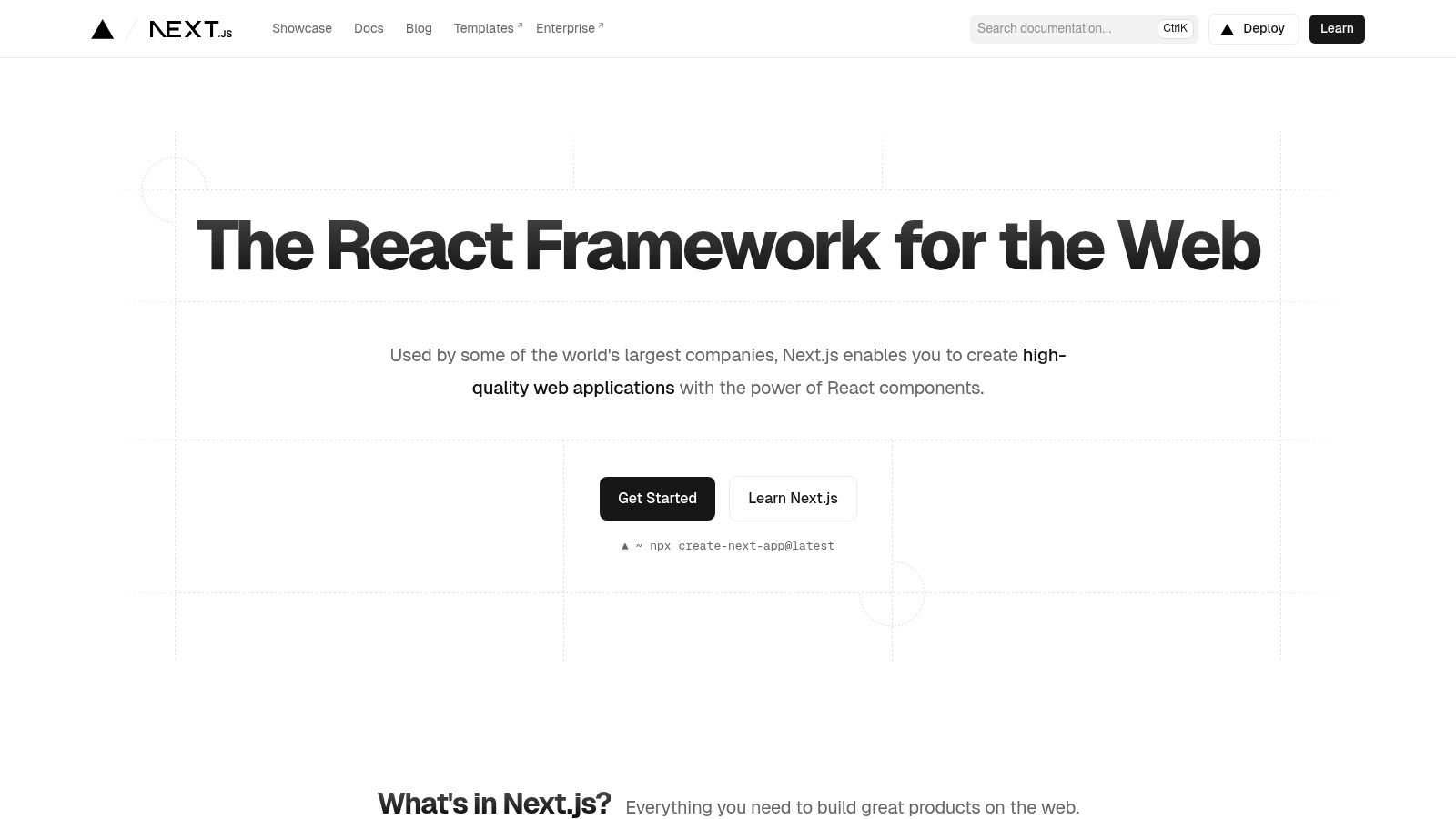
Next.js’s hybrid approach of combining SSR and SSG offers great flexibility. SSG is ideal for content-heavy sites like blogs or e-commerce product pages, as it generates static HTML files at build time, leading to exceptionally fast load times. SSR, on the other hand, comes into play for pages that require dynamic data fetching, like user dashboards or personalised content, rendering the page on the server for each request. This ensures that search engines can easily crawl and index the content, significantly boosting your website's visibility in search results. Next.js also includes features like automatic code splitting, which further optimizes performance by loading only the necessary JavaScript for each page. Built-in CSS and Sass support simplify styling, and API routes facilitate the creation of backend functionality directly within your Next.js application. The file-based routing system makes navigation management straightforward and intuitive.
For UK business owners, Next.js offers a compelling solution for building high-performing websites. Consider an e-commerce business aiming to improve its product page loading speed and search engine ranking. Next.js's SSG capabilities would significantly enhance the speed and discoverability of these pages, potentially leading to increased sales and brand visibility. Similarly, a news publisher could utilise Next.js to deliver news articles quickly and efficiently to readers, ensuring a smooth and engaging user experience.
Features:
Server-side rendering and static site generation capabilities
Automatic code splitting for faster page loads
Built-in CSS and Sass support with zero configuration
API routes for backend functionality
File-based routing system
Pros:
Excellent performance with server-side rendering and static generation
Minimal configuration required for many common use cases
Great developer experience with hot reloading
Strong SEO capabilities compared to client-side rendered apps
Cons:
Learning curve for teams unfamiliar with React or server-side concepts
Advanced customisations might necessitate more complex configurations
Although not mandatory, there's a closer integration with the Vercel deployment platform
Pricing: Next.js itself is an open-source framework, so it's free to use. However, deploying and hosting your Next.js applications might involve costs depending on the platform you choose (e.g., Vercel, AWS, Netlify).
Technical Requirements: A basic understanding of JavaScript and React is recommended. Setting up a development environment requires Node.js and npm (Node Package Manager).
Comparison: While other popular web frameworks like Gatsby and Nuxt.js offer similar features, Next.js strikes a balance between ease of use and advanced functionalities. It’s particularly well-suited for projects that benefit from both static and dynamic rendering.
Implementation Tip: Starting a new Next.js project is straightforward using the create-next-app command-line tool. This tool sets up a basic project structure, allowing you to begin development quickly.
Website: https://nextjs.org/
Next.js deserves a spot on this list of popular web frameworks because it delivers a comprehensive solution for building modern, performant web applications. Its flexibility, focus on developer experience, and built-in performance optimisations make it a powerful tool for businesses seeking a competitive edge in the digital landscape.
Laravel is a prominent player in the world of popular web frameworks, especially favoured for its elegant syntax and robust feature set. Created by Taylor Otwell, this PHP framework adheres to the Model-View-Controller (MVC) architectural pattern, simplifying the development process and boosting developer productivity without compromising the functionality of the final application. It's particularly well-suited for building complex web applications, APIs, and robust back-end systems. For business owners in the UK seeking a reliable and scalable framework, Laravel offers a compelling solution.
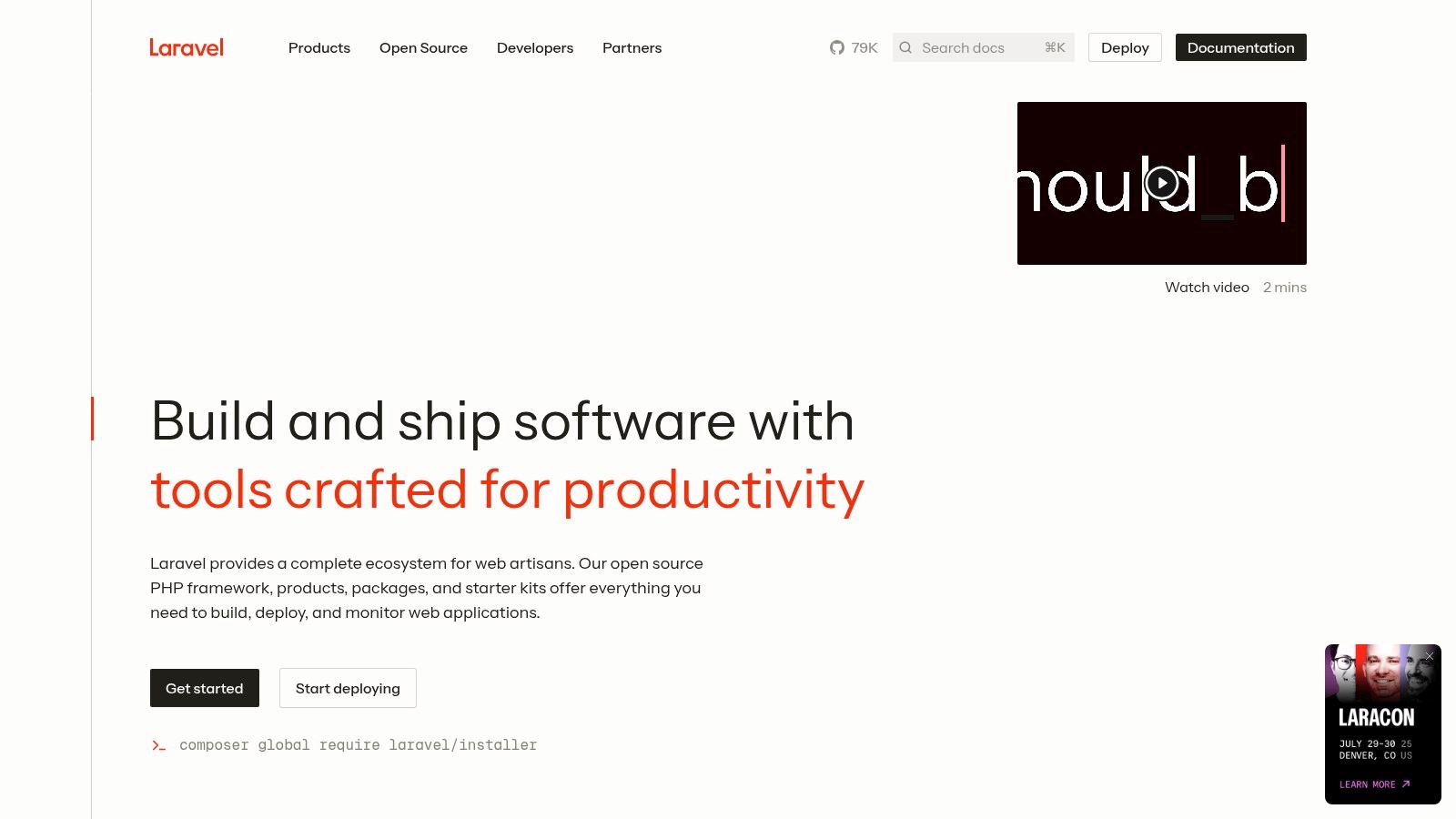
Laravel's popularity stems from its developer-friendly environment, which combines clean, expressive syntax with a comprehensive ecosystem. This ecosystem includes packages for common tasks like authentication, API development, and testing, significantly speeding up development. Features like its Eloquent ORM (Object-Relational Mapper) simplify database interactions, while the Blade templating engine provides a clean way to manage views. Artisan, the built-in command-line interface, automates common tasks, further enhancing efficiency. For example, if you need to set up user authentication, Laravel provides pre-built functionality, saving you considerable development time and effort.
Business owners will appreciate Laravel's focus on security. Built-in features like CSRF (Cross-Site Request Forgery) protection and input sanitisation mitigate common security risks. Furthermore, the extensive documentation and large community support make it easier to troubleshoot issues and find solutions. Learn more about Laravel to explore its potential for your business.
While Laravel is powerful, it’s important to consider its potential drawbacks. It can be slower than more lightweight PHP frameworks and might require more server resources. The learning curve can also be steeper for beginners compared to simpler frameworks, and it might be overkill for very basic applications.
Features:
Eloquent ORM: Simplifies database interactions.
Blade Templating Engine: Offers a clean and elegant way to manage views.
Artisan CLI: Automates repetitive tasks.
Built-in Authentication & Authorization: Streamlines security implementation.
Robust Queue & Job System: Enables efficient background processing.
Pros:
Clean and maintainable code: Enhances readability and reduces development time.
Comprehensive ecosystem: Provides readily available packages for common functionalities.
Strong security features: Protects against vulnerabilities.
Excellent documentation & community support: Facilitates troubleshooting and learning.
Cons:
Can be slower than lightweight frameworks: Performance can be a concern for high-traffic applications.
Steeper learning curve: Requires some initial investment in training.
Higher resource requirements: May need more robust server infrastructure.
Potentially excessive for simple projects: Might be overkill for basic websites.
Website: https://laravel.com/
Laravel's combination of powerful features, elegant syntax, and a thriving community makes it a deserving entry on the list of popular web frameworks. While it may not be the ideal solution for every project, its strengths make it a compelling choice for businesses looking to build robust, scalable, and secure web applications. If you're in the UK and considering a PHP framework, Laravel's mature ecosystem and supportive community offer a stable platform for long-term development.
Spring Boot earns its place among the popular web frameworks due to its ability to streamline the development of robust and scalable Java applications. It simplifies the process of building stand-alone, production-grade Spring-based applications that are easy to deploy and manage. This makes it particularly attractive for businesses in the UK looking to develop complex applications or microservices architectures with reduced development time and effort. By taking an "opinionated" view of the Spring platform, Spring Boot automatically configures many common components and dependencies, minimizing the boilerplate code developers need to write. This allows teams to focus on business logic rather than wrestling with configuration details.
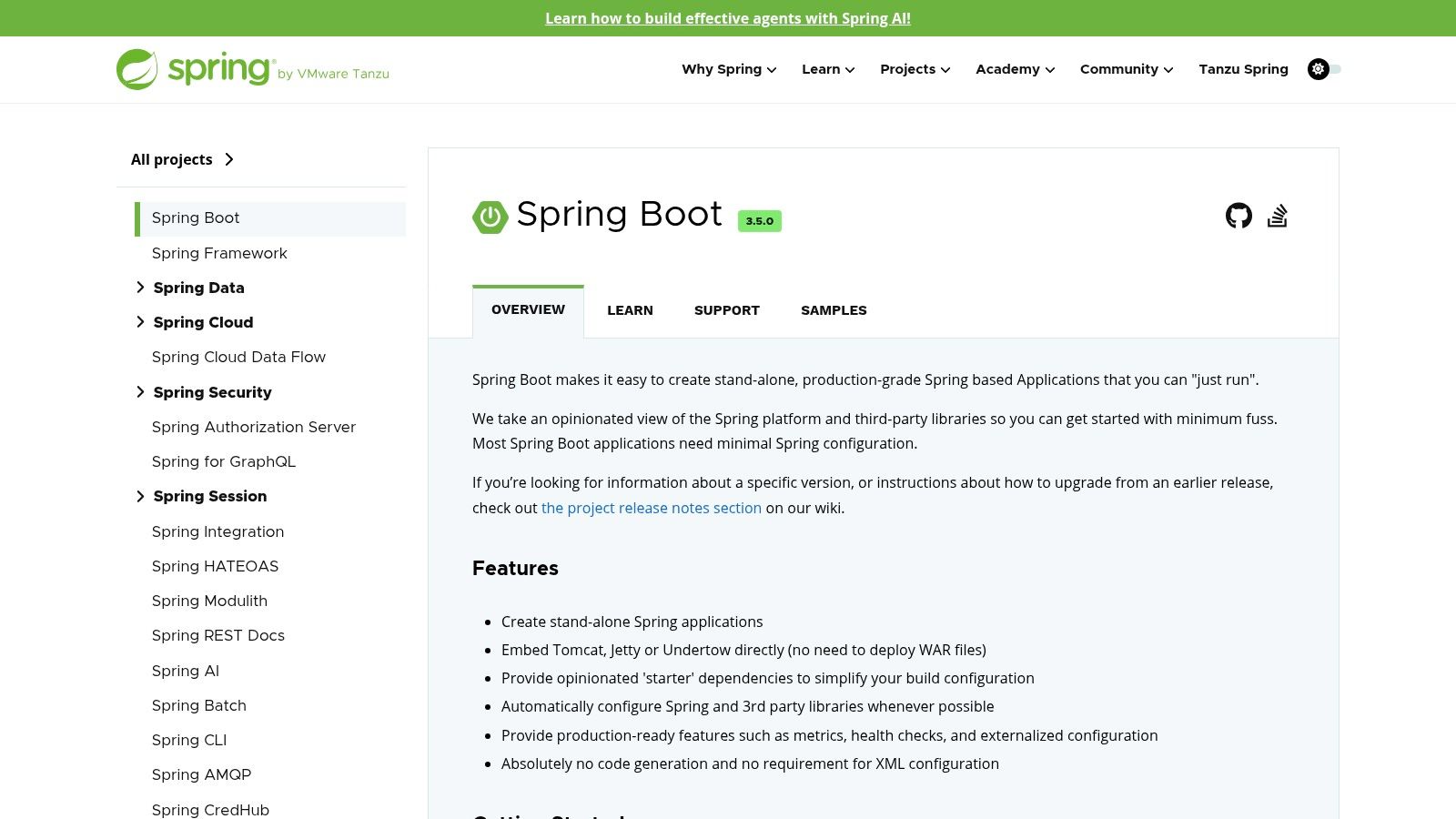
Spring Boot's key features include auto-configuration, reducing the need for explicit configuration; embedded server support (Tomcat, Jetty, and Undertow), simplifying deployment; and production-ready features like health checks and metrics, crucial for maintaining application performance and availability. Its seamless integration with the Spring ecosystem, including Spring Security, Spring Data, and Spring Cloud, provides a comprehensive platform for building enterprise-grade applications. The dependency management system with "starters" further simplifies dependency management, allowing developers to quickly include necessary libraries and functionalities.
For businesses, this translates to faster development cycles, reduced operational overhead, and the ability to build complex applications with greater ease. For example, UK businesses operating in regulated industries like finance or healthcare can leverage Spring Boot's strong security features and enterprise support to build compliant and secure applications. Moreover, its excellent support for microservices architectures makes it a compelling choice for businesses looking to build scalable and resilient systems.
Pros:
Reduced Boilerplate: Significantly less boilerplate code compared to traditional Spring development.
Enterprise-Grade: Strong support for enterprise features and robust security functionalities.
Microservices Ready: Excellent support for building and deploying microservices architectures.
Rich Ecosystem: Large ecosystem of modules and comprehensive documentation.
Cons:
Learning Curve: Can be challenging for developers unfamiliar with Java or the Spring framework.
Resource Intensive: Can have a larger memory footprint compared to lighter-weight frameworks.
Startup Time: Application startup can be slower compared to some alternatives.
Overkill for Simple Apps: Might be excessive for very simple applications where a lighter-weight framework might suffice.
Implementation Tips:
Leverage Spring Initializr (https://start.spring.io/) to quickly generate project skeletons with desired dependencies.
Use Spring Boot Actuator for production-ready features such as health checks and metrics.
Explore the Spring Boot documentation and community resources for guidance and best practices.
Comparison with Similar Tools: While frameworks like Micronaut and Quarkus offer similar benefits in terms of reducing boilerplate and improving startup times, Spring Boot benefits from a mature ecosystem and extensive community support, making it a more established and arguably less risky choice for enterprise applications.
Pricing: Spring Boot is an open-source framework and is free to use.
Technical Requirements: Requires Java Development Kit (JDK) and a suitable build tool like Maven or Gradle.
Website: https://spring.io/projects/spring-boot
Flask secures its spot among popular web frameworks due to its lightweight and flexible nature, making it a powerful tool for UK business owners looking for efficient web development solutions. It's a Python-based microframework built on the WSGI (Web Server Gateway Interface) standard, designed for rapid development and scalability. This means you can start small and easily expand your application as your business grows. Flask's minimalist approach gives developers the freedom to choose the tools and libraries they prefer, avoiding unnecessary dependencies and keeping the framework lean and fast. This translates to quicker development times and potentially lower hosting costs.

Flask is particularly well-suited for building RESTful APIs, which are essential for modern web applications and allow different systems to communicate effectively. Its integrated Jinja2 templating engine simplifies the creation of dynamic web pages, and support for secure cookies ensures client-side sessions are handled securely. The built-in development server and debugger streamline the development process, enabling developers to identify and resolve issues quickly. Furthermore, Flask boasts comprehensive unit testing support, ensuring the reliability and stability of your application.
For UK businesses, Flask presents an attractive option for several use cases. It's ideal for building:
Microservices: Flask's lightweight nature makes it perfect for creating individual components of larger applications, aligning with modern microservice architectures.
Web APIs: Quickly develop and deploy RESTful APIs for your web and mobile applications.
Prototypes and MVPs: Flask allows for rapid prototyping, letting you test your business ideas quickly and cost-effectively.
Data-driven applications: Flask can easily integrate with various databases and data visualisation libraries.
Features:
Built-in development server and debugger
RESTful request dispatching
Jinja2 templating engine integration
Support for secure cookies
Unit testing support
Pros:
Extremely lightweight and minimal
Highly flexible and unopinionated
Easy to learn and get started quickly
Perfect for small to medium projects and microservices
Cons:
Requires more manual setup for larger applications
Less built-in functionality compared to comprehensive frameworks (like Django)
Can lead to inconsistent project structures without disciplined developers
Limited built-in support for advanced features (often requires extensions)
Pricing: Flask is open-source and free to use.
Technical Requirements: Requires Python and optionally virtual environments for dependency management. Hosting requirements are minimal due to Flask's lightweight nature.
Comparison: Compared to Django, another popular Python framework, Flask is significantly more minimal. Django provides a more "batteries-included" approach with built-in features like an ORM (Object-Relational Mapper), while Flask allows developers more freedom to choose their preferred tools. This flexibility makes Flask ideal for smaller projects or where specific control over the technology stack is required.
Implementation Tips:
Start with a virtual environment to manage project dependencies.
Utilise Flask extensions for added functionalities like database integration (e.g., Flask-SQLAlchemy).
Follow best practices for structuring your project to maintain code clarity and maintainability as it grows.
Website: https://flask.palletsprojects.com/
Flask offers UK businesses a powerful, flexible, and cost-effective solution for web development. Its lightweight nature, coupled with its robust features, makes it a strong contender among popular web frameworks, particularly for businesses focused on agility and scalability.
Navigating the landscape of popular web frameworks can feel daunting, but with a clearer understanding of the strengths and weaknesses of each, you're now better equipped to choose the right tool for your project in 2025. From frontend giants like React, Angular, and Vue.js, to backend powerhouses like Express.js, Django, Ruby on Rails, and newer frameworks such as Next.js, Laravel, Spring Boot, and Flask, each offers a unique approach to web development. Remember that your choice depends on factors such as project scope, team expertise, scalability requirements, and the specific features you need.
One of the most important takeaways is that there's no one-size-fits-all solution. While JavaScript frameworks dominate the frontend, the best backend choice depends heavily on your project's specific needs. Consider whether you need a full-fledged framework like Django or Ruby on Rails, offering a comprehensive suite of tools and conventions, or a more minimalist microframework like Flask or Express.js, providing greater flexibility and control. When choosing a framework, it's essential to consider not just its technical capabilities but also its impact on developer experience. A positive developer experience leads to increased productivity, faster development cycles, and higher-quality code. To learn more about optimizing the developer experience, check out this helpful resource: improve developer experience
Choosing the right framework is a critical step towards building a successful web application. By carefully evaluating your project's unique requirements and considering the strengths of each framework, you can set your project up for success. Need expert guidance in navigating these choices and building robust, efficient web applications? iConcept specializes in Laravel development and can help you tailor solutions to your specific business needs. Visit iConcept to explore how we can help bring your vision to life.